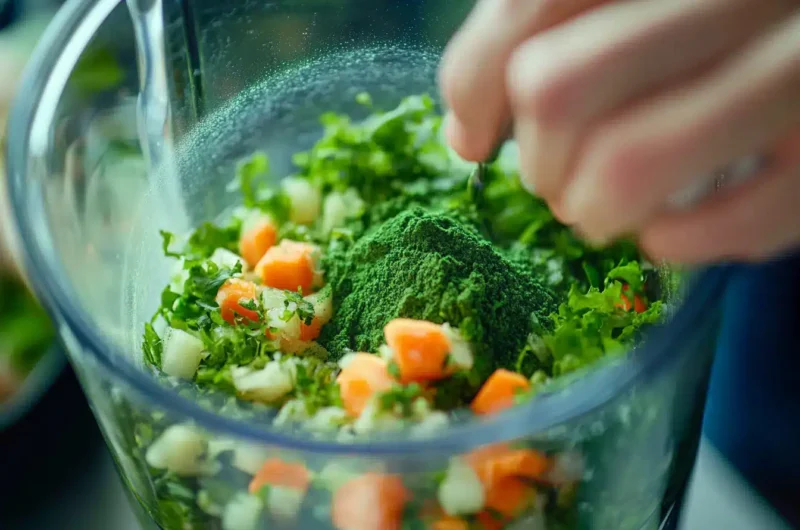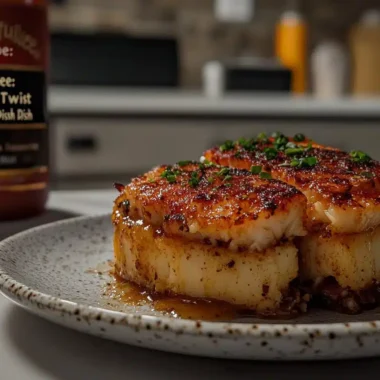Are you tired of the high costs and questionable ingredients in commercial fish food? Making your own fish food at home is a game-changer. This guide will show you how to make delicious, nutritious meals for your fish.
Key Takeaways
- Explore the cost-saving advantages of making your own fish food
- Gain control over the ingredients and ensure optimal nutrition for your fish
- Reduce your environmental impact by minimizing waste from store-bought options
- Discover the essential ingredients and tools needed to create homemade fish meals
- Learn step-by-step recipes and tips for customizing your fish’s diet
Understanding the Benefits of Homemade Fish Food
Making your own fish food at home has many perks. It’s cheaper and lets you control what your fish eat. This way, you can keep your fish healthy and happy.
Cost-Effective Alternative to Commercial Options
Homemade fish food saves money, especially if you have many tanks. Recipes can have over 55% protein, which is as good as expensive store food.
Control Over Ingredients and Nutrition
When you make your own fish food, you pick the ingredients. This means your fish get a diet that’s just right for them. You can avoid bad stuff in store food.
Environmental Impact Reduction
Homemade fish food is also better for the planet. It uses less packaging and local ingredients. This cuts down on waste and pollution.
Starting to make your own fish food is a smart move. It’s cheaper, lets you tailor the diet, and is better for the environment. With a bit of effort, you can give your fish the best care.
Essential Ingredients for Balanced Fish Nutrition
Creating a homemade fish food recipe is all about balance. You need high-quality proteins, vitamins, minerals, and other nutrients. Different fish species have unique dietary needs, so it’s important to choose the right ingredients.
Proteins are key for growth, muscle, and health. Fish meal, shrimp, and krill are top choices. They give your fish the building blocks they need to thrive.
Vegetables and greens are vital for vitamins and minerals. Spinach, spirulina, and kelp powder are great options. They’re full of vitamins A, C, and B, and minerals like calcium and iron.
Adding vitamin powders, calcium, and omega-3 fatty acids boosts nutrition. These extras help ensure your fish get a balanced diet. This supports their overall health.
By mixing these ingredients, you can make a homemade fish food that’s both balanced and nutritious. This way, you can tailor the diet to your fish’s specific needs. It helps keep them healthy and long-lived.
| Ingredient | Nutritional Benefits | Recommended Quantity |
|---|---|---|
| Fish meal or shrimp | High-quality protein for growth and muscle development | 1/2 cup |
| Spinach | Rich in vitamins, minerals, and antioxidants | 1/4 cup |
| Spirulina powder | Provides essential nutrients and promotes immune function | 1 tablespoon |
| Kelp powder | Packed with carbohydrates, fiber, and minerals | 1 tablespoon |
| Vitamin C powder | Supports overall health and immune function | 1/2 teaspoon |
| Omega-3 fish oil | Promotes healthy skin, fins, and organ function | 1 tablespoon |
| Gelatin or agar-agar | Acts as a binder to hold the ingredients together | 1 tablespoon |
By using these essential ingredients, you can make a homemade fish food that’s balanced and nutritious. It supports your fish’s health and well-being.
Required Tools and Equipment for Fish Food Recipe Preparation
Making tasty homemade fish food needs a few key tools and equipment. You’ll need basic kitchen items and special storage solutions. The right setup makes preparing fish food easy and efficient.
Basic Kitchen Equipment Needed
A good fish food prep station starts with a blender or food processor. It’s used to mix and grind ingredients well. You’ll also need measuring cups and spoons for accurate amounts, a cutting board, and a sharp knife for chopping.
Baking trays or a dehydrator are great for drying and keeping the food fresh.
Storage Containers and Materials
Storing fish food properly is crucial. Use airtight containers like mason jars or Tupperware to keep it fresh. For big batches, a five-gallon bucket and a drill with a mixing attachment are super helpful.
Safety Equipment Considerations
When working with certain ingredients, safety is a top priority. Wear gloves and a mask to protect yourself, especially with powdery or irritating ingredients. These simple steps ensure a safe and fun fish food prep experience.
Having the right tools and equipment makes making homemade fish food easier. It also keeps your fish food nutritious and fresh. With a well-stocked setup, you’ll be ready to give your fish a delicious and healthy meal.
Basic Fish Food Recipe for Beginners
Starting with a homemade easy fish food recipe can be a big help. It’s not only cheaper but also lets you control what your fish eat. Here, we’ll look at a simple homemade fish flakes recipe great for beginners.
The recipe combines high-quality fish flakes, oats, and spirulina powder in a 2:1:1 ratio. A bit of garlic is added for health benefits. Mix the dry ingredients, add water, and roll it out. Cut it into flakes and dry it to make the food ready for your tank.
This recipe gives your fish a balanced diet. Fish flakes provide nutrients, while oats and spirulina boost health. Garlic adds antibacterial and immune benefits.
You can adjust this recipe for different fish needs. For carnivores, add more protein. For herbivores, add more plants. The goal is to find the right mix for your fish’s health.
| Ingredient | Quantity |
|---|---|
| High-quality fish flakes | 2 parts |
| Finely ground oats | 1 part |
| Spirulina powder | 1 part |
| Garlic (minced or powder) | to taste |
With this easy fish food recipe, you can give your fish a healthy, homemade diet. Enjoy making your own homemade fish flakes and see your fish flourish!
Understanding Fish Dietary Requirements
Keeping your fish healthy means giving them the right food. Each fish needs different nutrients based on its type and how it eats. Knowing what your fish needs helps them stay happy and healthy in your tank.
Protein Requirements
Protein is key for fish growth. They need it from foods like fish meal, shrimp, and spirulina. Some fish, like goldfish, eat mostly plants. Others, like carnivores, need more animal proteins.
Essential Vitamins and Minerals
Fish need vitamins and minerals for health. You can find these in veggies, fruits, and fish supplements. Vitamin C is especially important since fish can’t make it themselves.
Healthy Fats and Supplements
Healthy fats, like omega-3s and omega-6s, keep fish skin and fins healthy. Adding supplements like Zoecon and Selcon can help. But, use them carefully to avoid problems like fatty liver disease.
Knowing what your fish need helps you feed them right. Talking to an aquarium expert or doing your homework can help you make a good feeding plan. This way, your fish will be happy and healthy in your tank.
Step-by-Step Fish Food Recipe Guide
Making your own fish food at home is rewarding. It lets you pick the ingredients and make sure your fish eat well. This guide will help you make a balanced meal for your fish.
First, you need the right ingredients. You can use flakes, granules, or pellets. For herbivorous fish, try frozen spirulina cubes. Carnivorous fish love fish products like salmon and shrimp. Add veggies like lettuce and spinach for extra nutrients.
- Start by grinding protein sources like fish or shrimp in a food processor until they’re fine.
- In a big bowl, mix dry ingredients like flakes or supplements well.
- Add wet ingredients like gelatin or fish oil slowly. Mix until it’s like dough.
- Shape the mix into pellets or cubes using molds or your hands.
- Put the shaped food on dehydrator trays or a baking sheet lined with parchment. Dry at 135°F (57°C) until it’s hard.
- When it’s dry, store it in airtight containers in a cool, dry spot.
Follow this guide to make fish food that’s good for your fish. Enjoy making your fish happy with a homemade, healthy meal.
Proper Storage and Preservation Methods for Fish Food Recipe
Keeping your homemade fish food fresh and nutritious is key for your fish’s health. Using the right storage and preservation methods can help keep your DIY fish food fresh longer. This ensures your fish get the nutrients they need. Let’s look at the best ways to store and keep your aquarium food fresh.
Storage Container Options
Airtight containers are best for storing homemade fish food. Glass jars or BPA-free plastic containers work well because they keep food fresh and prevent contamination. Make sure the containers are without cracks or damage to keep the food quality high.
Temperature and Humidity Control
Keep your fish food in a cool, dry spot away from sunlight. Refrigeration can keep it fresh for up to 3 days. Freezing can extend this to 6 months. Vacuum sealing can keep it good for up to 12 months. Keeping the right temperature and humidity stops bacteria and keeps your fish food fresh.
Signs of Spoilage to Watch For
- Discoloration or changes in the food’s appearance
- Unpleasant odors or a slimy texture
- The presence of mold or other visible signs of spoilage
If you see any of these signs, throw out the fish food. This keeps your aquarium safe and healthy. Watching for these signs helps keep your preserving aquarium food at its best.
By using these storage and preservation tips, you can make your homemade DIY food last longer. This way, your fish will get the nutrients they need to stay healthy and happy.
Common Mistakes to Avoid When Making Fish Food
Making homemade fish food can be rewarding, but it’s key to avoid common mistakes. Not balancing nutrients properly can harm your fish. Using onions or garlic is also bad, as they can be toxic.
It’s also important to tailor the recipe to your fish’s needs. Different fish need different diets. Overprocessing ingredients can also reduce their nutritional value.
Keeping the preparation area clean is crucial to avoid contamination. Overfeeding can also pollute the water and harm water quality.
- Avoid nutrient imbalances by carefully researching and balancing the ingredients.
- Steer clear of using onions, garlic, or other potentially toxic ingredients.
- Tailor the recipe to the specific dietary needs of your fish species.
- Don’t over-process ingredients, as this can diminish the nutritional value.
- Maintain strict hygiene standards to prevent contamination.
- Be mindful of portion sizes to avoid overfeeding and water pollution.
By avoiding these common fish food errors, aquarium diet mistakes, and homemade food pitfalls, you can ensure your fish receive the balanced and nutritious diet they require to thrive.
| Statistic | Value |
|---|---|
| Adults lacking confidence in cooking fish and seafood | 1 in 4 |
| Recommended cooking time for pan-fried fish | 3 to 5 minutes per side |
| Recommended internal temperature for cooked fish | 145°F |
| Increase in fresh seafood sales during December 2020 | 25% |
| Increase in frozen seafood sales during December 2020 | 26% |
| Adults confident in prepping seafood at home (2019 survey) | 1 in 4 |
| Spending on seafood from restaurants vs. retail (2017) | 2x more at restaurants |
Customizing Recipes for Different Fish Species
Homemade fish food must be tailored for each fish type. Each species has its own needs, and making custom diets is essential. Knowing what each fish needs is key to feeding them right.
Herbivorous Fish Recipes
Herbivorous fish need lots of greens and plants in their food. Spinach, kale, zucchini, and broccoli are great choices. They give these fish the vitamins and fiber they need to stay healthy.
Carnivorous Fish Recipes
Carnivorous fish, on the other hand, need lots of protein. Their food should include white fish, shrimp, and even beef heart. This helps them grow strong, just like they do in the wild.
Omnivorous Fish Options
Omnivorous fish eat both plants and meat. Their food should mix vegetables and protein sources. This way, fish like goldfish and guppies get the right mix for their health.
By making food that fits each fish’s needs, you can keep them healthy. This ensures your fish get the best nutrition in your aquarium.
Measuring and Portioning Guide
It’s key to portion food right for your fish’s health. Feed them small, frequent meals, 1-2 times a day. The right amount depends on their size and type.
For homemade fish food, use the same size portions. Ice cube trays or small bags are great for this. A 2×2 inch square from a zip-lock bag or 1-4 mini ice cubes work for 500-gallon tanks. Adjust portions based on your fish’s eating and tank cleanliness.
| Food Item | Recommended Portion Size | Visual Guide |
|---|---|---|
| Meat or Fish | 3 to 4 ounces | Size of a deck of cards or palm of the hand |
| Dried Rice or Pasta (Main Meal) | 2 handfuls (75g) | – |
| Dried Rice or Pasta (Side Dish) | 1 handful (37g) | – |
Adjust portions for your fish’s specific needs. By measuring and portioning well, you help your fish get the nutrients they need to do well.
Tips for Enhancing Nutritional Value
To boost fish food nutrition, try different strategies. Use fresh, high-quality ingredients to make a balanced diet. This will help your fish stay healthy and thrive.
Adding supplements like vitamin C powder, spirulina, or fish oil can help. These ingredients provide essential nutrients. Spirulina, for example, is packed with vitamins, minerals, and antioxidants. It’s great for any aquarium diet.
- Use color-enhancing ingredients like spirulina and carrots for a vibrant look.
- Make sure your fish get a variety of proteins, such as white fish, shrimp, and peas.
- Include fresh veggies like spinach, kale, and broccoli for vitamins and minerals.
Watching your fish’s health and appearance helps you adjust their diet. By paying attention to their needs, you can create a nutritious diet. This will keep your fish happy and full of energy.
| Ingredient | Nutritional Benefits |
|---|---|
| Spirulina | High in vitamins A, C, B-12, and minerals like iron, calcium, and zinc |
| Garlic | Antibacterial properties that support fish health and increase appetite |
| Carrots | Rich in beta-carotene, which can enhance fish coloration |
| Greens (Spinach, Kale, Broccoli) | Provide a variety of vitamins, minerals, and fiber for a balanced diet |
By following these tips, you can make homemade fish food that’s nutritious. It will meet your fish’s needs and improve their health and energy. This ensures they thrive in your aquarium.
Conclusion
Making your own fish food has many advantages. It’s cheaper than buying it and lets you pick what goes into it. This way, you can make sure your fish get exactly what they need. Plus, it’s better for the planet since it cuts down on packaging waste.
With the right recipes and tips, you can make food that’s good for your fish. This can make them healthier and more colorful. It’s also a fun way to care for your fish, no matter what kind they are.
In short, making your own fish food is a smart choice. It’s good for your fish and for the environment. It’s a great way to improve your aquarium and the health of your fish.
Fish Food Recipe FAQ
What are the benefits of making homemade fish food?
Making your own fish food saves money and lets you choose what goes into it. It ensures your fish get the nutrients they need. Plus, it’s better for the environment because it uses less processed stuff.
What are the essential ingredients for homemade fish food?
You’ll need high-quality proteins like fish meal and shrimp. Add veggies for vitamins and minerals, like spinach and spirulina. Don’t forget supplements like vitamin powders and omega-3 fatty acids.
What tools and equipment are needed for making homemade fish food?
You’ll need a blender, measuring cups, a cutting board, and a knife. Also, baking trays or a dehydrator, and containers for storing it. Safety gear like gloves and masks is a good idea too.
What is a simple recipe for beginners to try?
Start with a mix of fish flakes, oats, spirulina powder, and garlic. Use a 2:1:1 ratio, then add water to make a dough. Roll it thin, cut into flakes, and dry completely.
How do I properly store and preserve homemade fish food?
Keep it in airtight containers, like glass jars or BPA-free plastic. Store it in a cool, dry place, away from sunlight. Freezing can keep it fresh for months. Check for spoilage signs like bad smells or mold.
What common mistakes should I avoid when making homemade fish food?
Avoid unbalanced nutrients, harmful ingredients, and over-processing. Make sure the recipe fits your fish’s needs. Keep it clean and don’t overfeed.
How do I customize recipes for different fish species?
Tailor recipes to your fish’s diet. Herbivores need more greens, while carnivores need protein. Omnivores need a mix. Adjust the recipe to fit your fish’s needs.
How do I properly portion and feed homemade fish food?
Feed small amounts often, 1-2 times a day. Portion sizes depend on the fish’s size and type. Use a 2×2 square or 1-4 mini ice cubes for tanks around 500 gallons. Adjust based on how much they eat and tank cleanliness.
How can I enhance the nutritional value of homemade fish food?
Add supplements like vitamin C powder and spirulina. Use fresh, high-quality ingredients. Add color with spirulina and carrots. Mix different proteins and veggies for a balanced diet.






